County: Donegal Site name: GLEBE, CO. DONEGAL
Sites and Monuments Record No.: SMR DG028-033 SMR DG028-024 SMR DG028-027 Licence number: E1052
Author: ANDREW HALPIN
Site type: Iron Age and early medieval graves, c. 300 BCc. AD 1200
Period/Dating: —
ITM: E 630081m, N 929820m
Latitude, Longitude (decimal degrees): 55.114863, -7.528495
Introduction
In January 1995 a lintel grave containing an inhumation burial was discovered on Killygarvan Island near Mountcharles, Co. Donegal. It was located on the south side of the island, where erosion had exposed it in long section. The grave had been partially destroyed and lay on the high-tide line. Some of the human remains eroding out of the section had been removed to Donegal County Museum. The site was reported to the NMI by Joanna Nolan and a rescue excavation was undertaken by Andrew Halpin. A number of lintel graves had been excavated in the same location by Raghnall Ó Floinn in 1988 (Ó Floinn 1992b). The human remains were examined by Barra Ó Donnabháin.
Location (Fig. 4.5)
The site, in the townland of Glebe on Killygarvan Island, north Co. Donegal,13 is a tidal island at the northern end of Kinnegar strand in Lough Swilly, 3km north of Rathmullan. The closest church, Killygarvan Church, was located 200m to the west.14 An early Bronze Age cemetery cairn was located some 20m south-west of the cemetery.15


Description of site
The cist was rectangular in plan, with its long axis aligned east/west. The surviving portion measured approximately 1.7m long by 0.4m wide by 0.3m high (Fig. 4.6). Erosion had exposed the southern side of the cist, and only two collapsed side stones survived. The north side was formed of three edge-set slabs, each approximately 0.5m in length, with the flat sides facing inwards. The ends of the cist were not closed, but one stone found lying flat near the west end might represent a collapsed end stone. A number of courses of flat stones survived above the southern side walls. This construction of courses above the edge-set slabs was also seen in grave 1 of Ó Floinn’s excavation at Killygarvan (Ó Floinn 1992b, 42), where they appeared to have been put in place to level off the covering stones. Only two overlapping covering stones—lintels—survived in situ, and these were on the east end, resting on the side stones. The floor of the cist was paved with small stones, the largest measuring 0.3m by 0.11m. This floor appears to have been eroded at the south side of the cist. As with the cists excavated by Ó Floinn, there was very little distinction between the pit cut and the surrounding soil; it appears to have been cut into loose, gravel-rich loam and filled with a similar material.
The cist contained an extended inhumation of an adult female (1995:175) lying west/east and no accompanying artefacts were found. Much of the skeleton had been removed prior to excavation, but the skull was found at the western end.
Comment
Although partially destroyed, it appears that this was a lintel grave similar to those excavated by Ó Floinn at the same site in 1988 (Ó Floinn 1992b).
HUMAN REMAINS
BARRA Ó DONNABHÁIN
Introduction
The remains (1995:175) consist of fragments of the skeleton of an adult female. The bones are poorly preserved. The cortical surfaces of most of the bones recovered have been severely eroded. The remains recovered include portions of the skull as well as fragments of the right clavicle, an unsided humerus, the left radius, right ilium, left ischium, the shaft of the right femur, the head and shaft of the left femur, the shaft of the right tibia and portions of five vertebrae: T10, L2, L3, S2 and S3.
Age and sex
The morphology of the pelvis and cranium indicates that this individual was female. This is confirmed by metrical analysis: the head of the left femur has a diameter of 40.21mm. The elements of the sacrum were in the process of fusing when death occurred. This suggests an age at death of 20–25 years. The absence of age-related degenerative changes in the bones supports this estimate.
Teeth
The following teeth were present in the jaws at the time of death:

The mandible and the remaining portion of the maxilla were not recovered. The following teeth were lost post-mortem:

Small amounts of dental calculus are present on the first and second upper left molars. This is a common feature in most populations. The teeth do not have any evidence of caries (tooth decay). The degree of attrition (wear) observed is heavy by modern standards but only moderate when compared with that of earlier populations. This is clearly a function of the relatively young age at death of this individual: had she lived longer, the attrition would have been heavier. Secondary dentine is exposed on the occlusal surfaces of all of the teeth Recovered.
Linear enamel hypoplasia was not noted in the teeth.
Pathology and anomalies
A trace of a metopic suture was retained in the region of the glabella.
The only pathological change observed in the skeleton was the presence of a mild form of cribra orbitalia in the orbits. These lesions had healed at the time of death and may represent a more severe manifestation of the condition during childhood. Cribra orbitalia is generally accepted as being the result of iron-deficiency anaemia. Iron deficiency in the blood (hypoferraemia) may be an adaptive response to a heavy disease load and/or micro-organism invasion. The presence of the condition is therefore an indication that the body had rallied in the past against some form of systemic disturbance.
13. Parish of Killygarvan, barony of Kilmacrenan. SMR DG028-033——. IGR 230136 429836.
14. SMR DG028-024. IGR 32562 9839.
15. SMR DG028-027.